With this series of weekly updates, WOLA seeks to cover the most important developments at the U.S.-Mexico border. See past weekly updates here.
Subscribe to the weekly border update Support the Beyond the Wall campaign
Will Title 42 end? What might happen next?
“Title 42,” the pandemic emergency provision the Trump and Biden administrations have used to rapidly expel migrants from the U.S.-Mexico border region more than 1.7 million times, may be nearing an end as U.S. COVID case rates and restrictions fall. The provision, which the Department of Homeland Security (DHS) has used to expel even migrants claiming fear for their lives if removed, is up for renewal at the end of March or beginning of April, and it’s not clear whether it will be prolonged or allowed to lapse.
Late on March 11, the Centers for Disease Control (CDC) altered its March 2020 order, exempting unaccompanied children. In practice, no non-Mexican unaccompanied children had been expelled since November 2020, when a Washington, DC District Court judge halted such expulsions. In January 2021, though, that judge was overruled by a DC Circuit Court panel-but the new Biden administration refused to expel unaccompanied children. On March 4 a District Court judge in Texas went further, seeking to compel the administration to resume expelling unaccompanied children; the response was the March 11 CDC modification to its Title 42 order.
A CDC document accompanying that modification noted that the next 60-day renewal of Title 42 is imminent. The deadline is either March 30 or “early April.” Whether the public health agency will renew it is not clear. “We continue to defer to the CDC on the use of Title 42 and how long it might remain in effect,” a White House official told Axios.
On a March 17 call with reporters, DHS Secretary Alejandro Mayorkas said the CDC’s decision will depend on “where we are in the arc of the COVID-19 pandemic,” noting that new coronavirus variants have emerged. “If BA.2 variant drives up cases,” the Washington Post’s Nick Miroff tweeted, “it wouldn’t be the first time DHS preparations for ending T42 are stalled by covid resurgence, giving Biden admin public health rationale for extending it.”
Several events in the past week have increased pressure on the Biden administration to do away with Title 42 once and for all.
- Outrage followed Customs and Border Protection (CBP) officers’ use of Title 42 authority to turn away Ukrainian asylum seekers at the main Tijuana-San Diego port of entry. The first Ukrainians arrived on March 7, and U.S. lawyers in Tijuana had to fight hard to get CBP to admit the families, part of a flow of refugees from the Russian invasion who had flown to Mexico with the intent of seeking asylum in the United States. By March 17, Mayorkas said, DHS had issued guidance to CBP officers stationed at the borderline to consider using the discretion that Title 42 gives them to make exceptions. A separate DHS policy is offering Ukrainians a one-year grant of humanitarian parole in the United States-not asylum, which must be granted in immigration court-on a case-by-case basis.
- “Advocates for migrants said the DHS guidance for Ukrainians showed unequal and discriminatory treatment of asylum-seekers based on their countries of origin, which is barred under international refugee law,” CBS News reported. Among the many nationalities whose asylum seekers remain frozen out of U.S. ports of entry by Title 42 are Russians fleeing persecution from the Putin regime. Tijuana municipal authorities even issued Russians a letter in their native language warning them to vacate the vicinity of the port of entry.
- In a new quarterly report, Human Rights First revealed that it has tracked “at least 9,886 kidnappings, torture, rape, and other violent attacks on people blocked in or expelled to Mexico due to the Title 42 policy under the Biden administration.”
- This week the Biden administration’s 209th removal flight departed for Haiti; about two-thirds of the 20,700 Haitians aboard these planes have been Title 42 expulsions. “Stop deporting and expelling people to Haiti. Now,” read a letter to Mayorkas and CDC Director Rochelle Walensky from Reps. Mondaire Jones (D-New York) and Ayanna Pressley (D-Massachusetts), whose districts have large Haitian-American populations.
- The Senate’s majority leader, Sen. Chuck Schumer (D-New York), was among four Democratic senators whose March 12 statement read, “We are deeply disappointed in the Biden Administration’s decision to maintain Title 42. While we recognize that the Administration made the right choice to prevent unaccompanied children from being expelled, it is wrong that they made the decision to continue sending families with minor children back to persecution and torture.” Talking to reporters during the week of March 7, Schumer added, “it’s unacceptable that this policy continues to be used indiscriminately to remove migrants with valid refugee claims from our southern border.”
- “Enough is enough,” read a March 12 statement from Congressional Hispanic Caucus Chair Rep. Raúl Ruiz (D-California). “It is long overdue to completely end the Trump-initiated Title 42 policy and stop using the pandemic as an excuse to keep it going.”
Should Title 42 end in about two weeks, many asylum-seeking migrants may seize the long-delayed opportunity to present at, or between, ports of entry to turn themselves in to U.S. authorities. It is not clear that DHS has been putting in place the infrastructure and personnel necessary to process that massive protection demand in an orderly way. Though images of a chaotic rush to the border could create political problems for the Biden administration as midterm legislative elections approach, preparations at the border appear to be incipient.
Secretary Mayorkas told reporters that DHS is “operationalizing preparations for different possibilities.” Axios reports that “U.S. intelligence officials are privately bracing for a massive influx of more than 170,000 migrants at the Mexico border.”
Axios reporters Jonathan Swan and Stef Kight note that the Biden administration is putting together a Southwest Border Coordination Center (SBCC), based in Washington and headed by Border Patrol official Matthew Hudak. This SBCC, which is still forming, will be “essentially a war room to coordinate an interagency response,” incorporating personnel from the Departments of Homeland Security, State, Justice, Defense, and Health and Human Services (HHS). Other preparations underway, according to Swan and Kight, include:
- Meetings among officials from different agencies to draw up a “Southwest Border Mass Irregular Migration Contingency Plan.”
- A March 16 call on DHS employees “to consider stepping forward to support the DHS Volunteer Force” to help process large numbers of migrants at the border.
- The possibility of surging “hundreds or thousands” of additional personnel from DHS’s component agencies and from HHS.
- Possible requests to the U.S. Marshals Service and Defense Department for air and ground transportation to transfer migrants.
- Possible requests for “dozens of buses from the Bureau of Prisons to transport migrants between DHS facilities.”
- Possible expansion or construction of tent-based facilities for short-term processing and sheltering of “up to 2,000 migrants apiece.”
As these preparations are all in their early stages, there is a strong likelihood that CBP’s existing processing capacity might be overwhelmed if Title 42 abruptly terminates at the end of March. Border-zone nonprofits and service providers, like the San Diego and Tijuana-based Al Otro Lado, note that they could play a big role in helping to make the flow more orderly, but that they have received no response from the U.S. government.
Preparations for a post-Title 42 reality have included diplomatic efforts. BuzzFeed reported that DHS officials have been planning to tell Mexican counterparts that Title 42 “may come to an end as soon as April, which could lead to an increase of immigrants coming to the border and a strain on resources.” DHS Secretary Mayorkas was in Mexico City on March 14, his fourth visit to Mexico, where he discussed migration with President Andrés Manuel López Obrador and other top officials. The next day Mayorkas was in Costa Rica, where he signed a migration cooperation arrangement with authorities in San José. In February Costa Rica started requiring visas for Venezuelans and Cubans.
More Colombians and Cubans, fewer Venezuelans and families, encountered in February
CBP released its latest update of data about migration at the U.S.-Mexico border, covering February. It found a slight increase in migrant arrivals over January, led by single adults and unaccompanied children. Arrivals of families fell, as did migrants from Venezuela. Here are some highlights:
CBP has encountered migrants at the border 838,685 times in the first five months of fiscal year 2022. During the first five months of fiscal 2021, the agency had 397,549 encounters. At the current rate, migrant encounters would exceed 2 million for the first time ever.
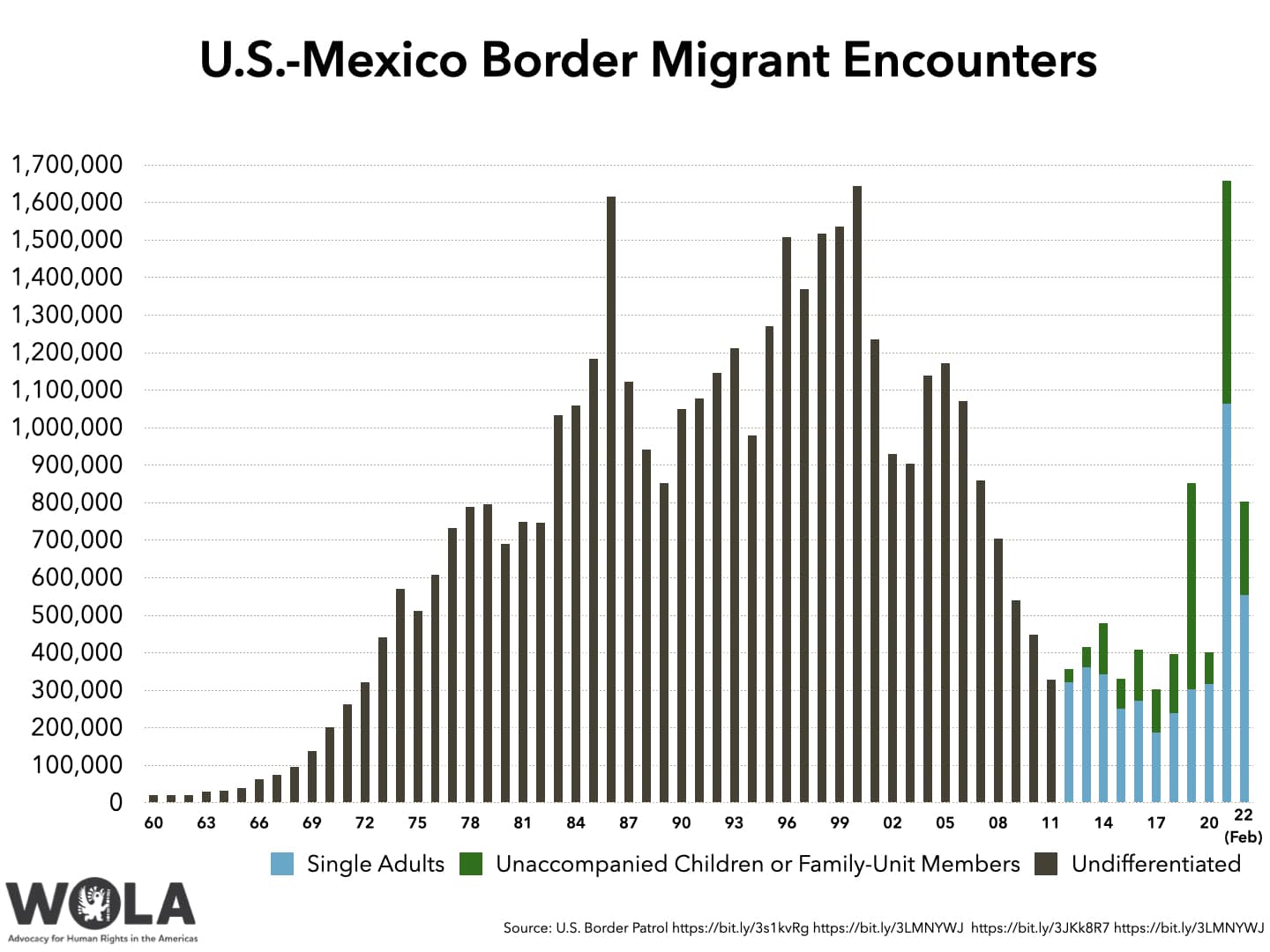
The 164,973 migrant encounters in February were the most in a month of February since 2000. This represented a 7 percent increase over January, which is usually a less-busy month. Numbers are likely to increase throughout the spring even if Title 42 remains in place.

“Encounters” include a lot of repeat crossers, especially now that Title 42’s rapid expulsions facilitate numerous attempts. CBP reported encountering 116,678 actual individual migrants in February, a 5 percent increase over January’s reported number (though CBP’s release calls it a 2 percent increase). 30 percent of encounters were with migrants whom the agency had already apprehended at least once. (The “re-encounter rate” was just 14 percent between 2014 and 2019.)
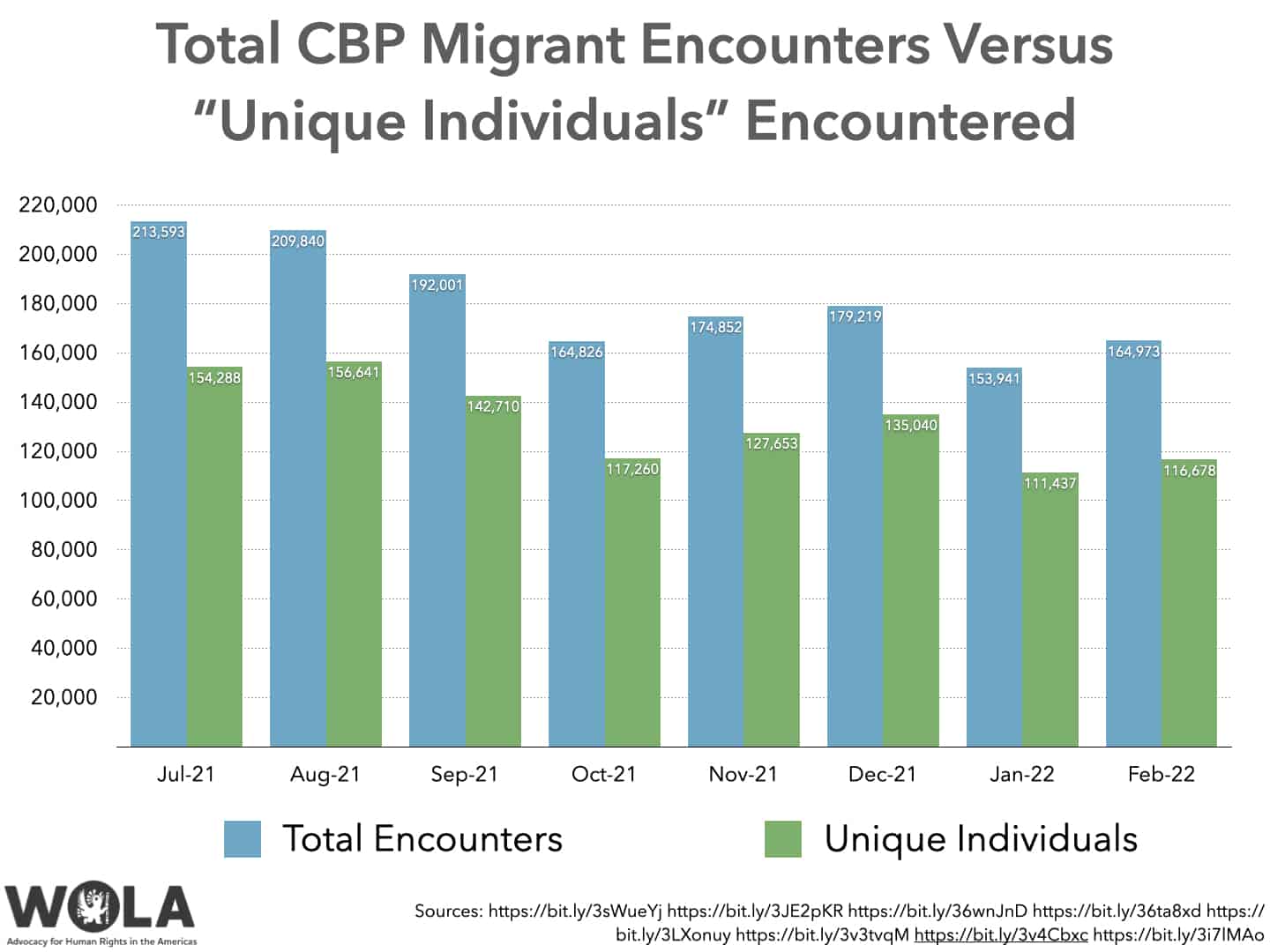
February saw the largest number of people expelled under Title 42 since October: 91,513, or 55 percent of all encounters. As of February 28, CBP had expelled migrants on 1,706,076 occasions.
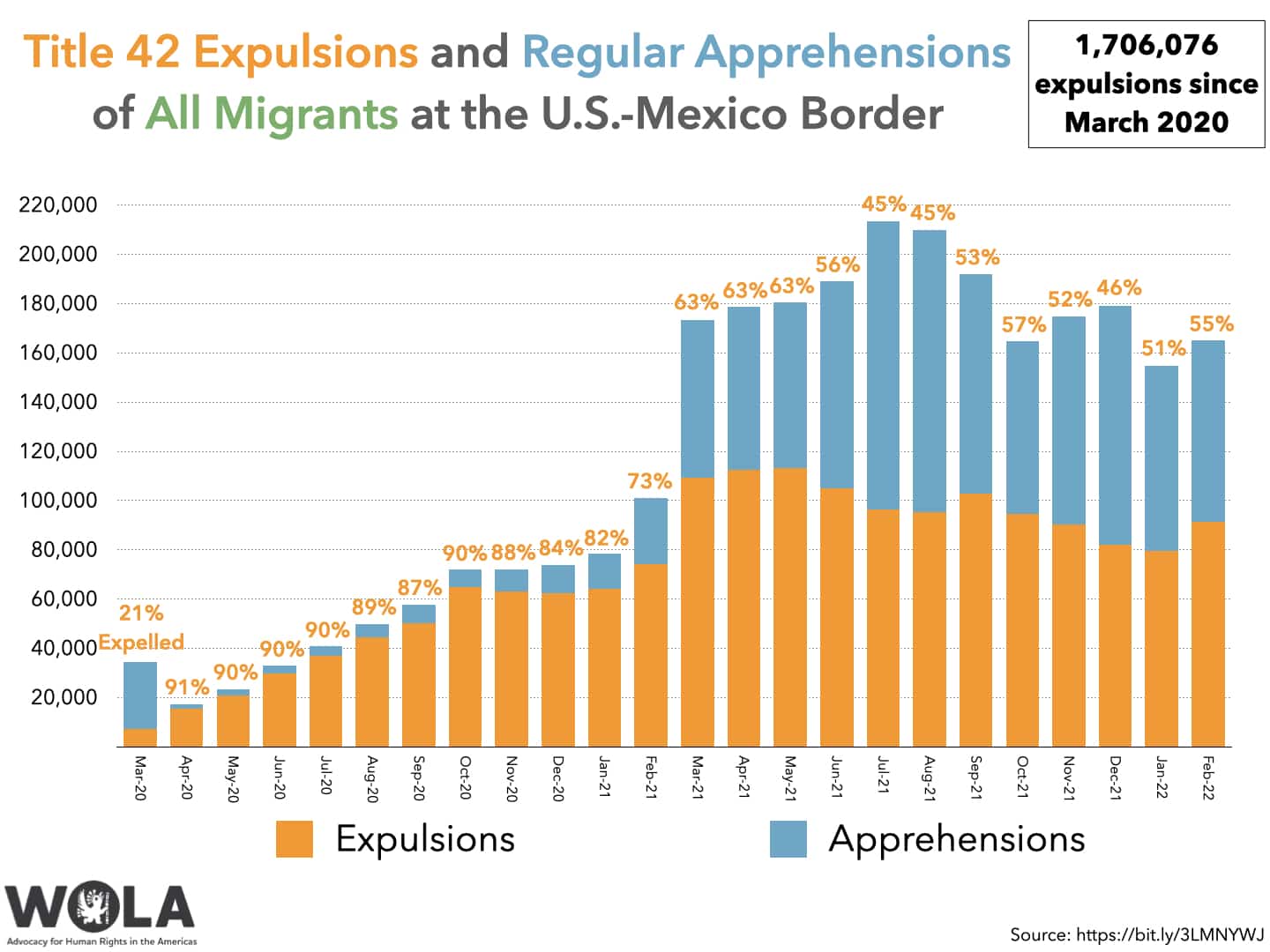
Arrivals of family units (parents with children) continued a long decline. 26,811 family-unit members were encountered in February, down 69 percent from August (87,054). Of those, less than 19,000 avoided expulsion under Title 42. Only about 3,000 of these non-expelled families came from Mexico or from Central America’s “northern triangle” countries (El Salvador, Guatemala, and Honduras).
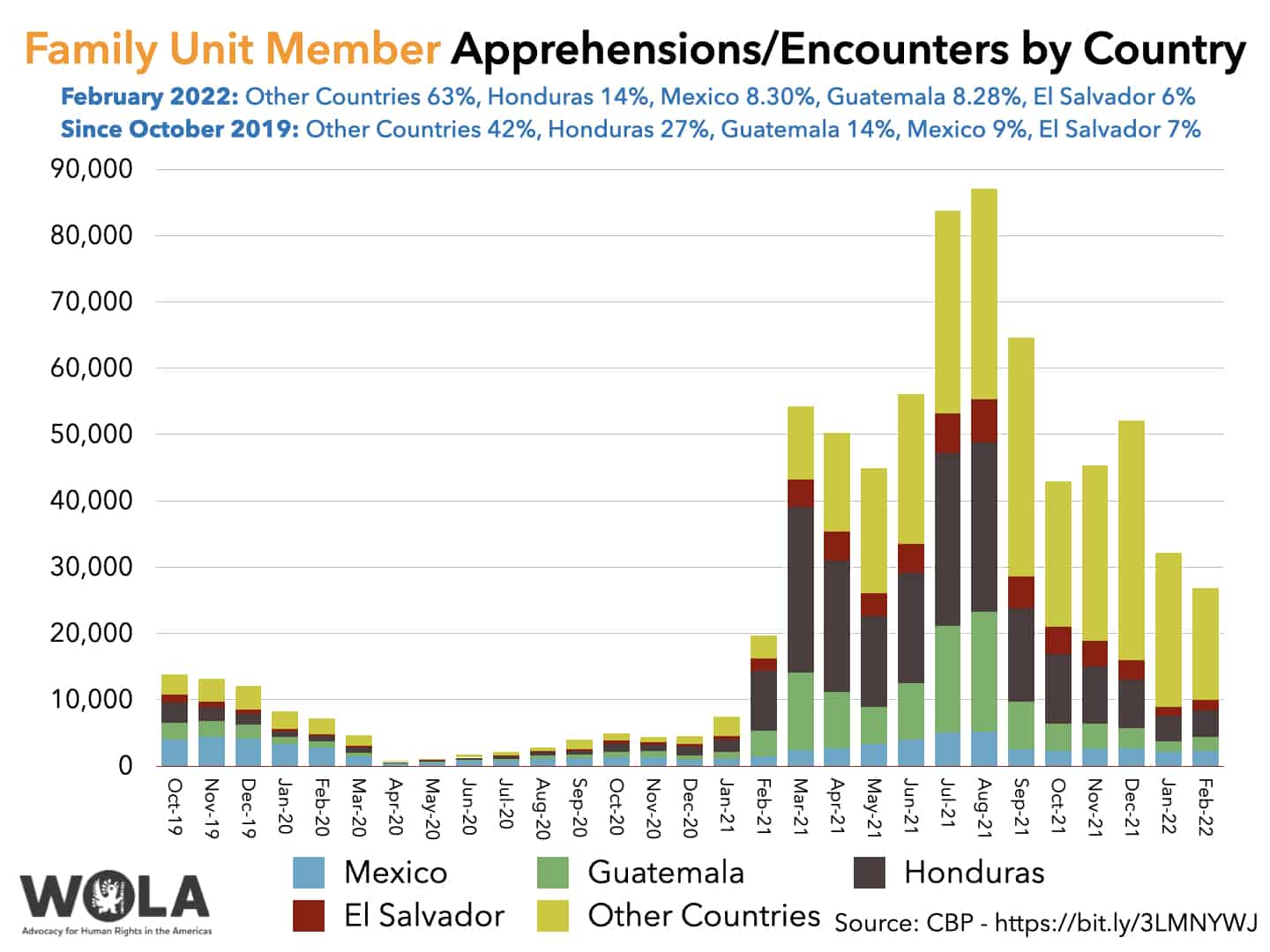
After dipping in January, encounters with unaccompanied children increased 37 percent in February, to 12,011. On an average day in February, CBP had 520 unaccompanied kids in short-term custody, up from 295 in January.
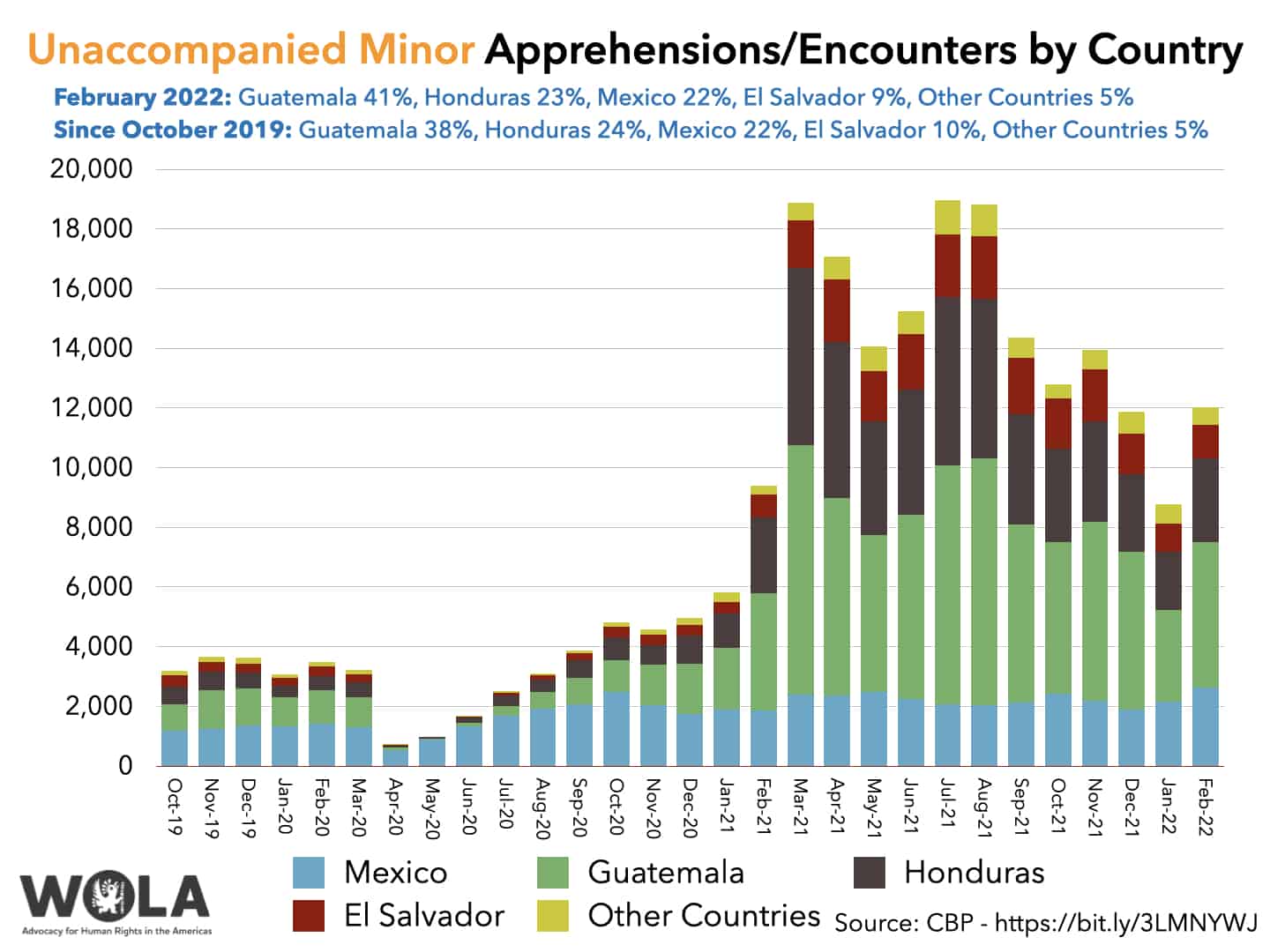
Encounters with single adults, meanwhile, hit their highest monthly total since CBP started publicly breaking down data by demographic group in October 2011. 126,151 of February’s encounters-76 percent of the total-were with single adults.
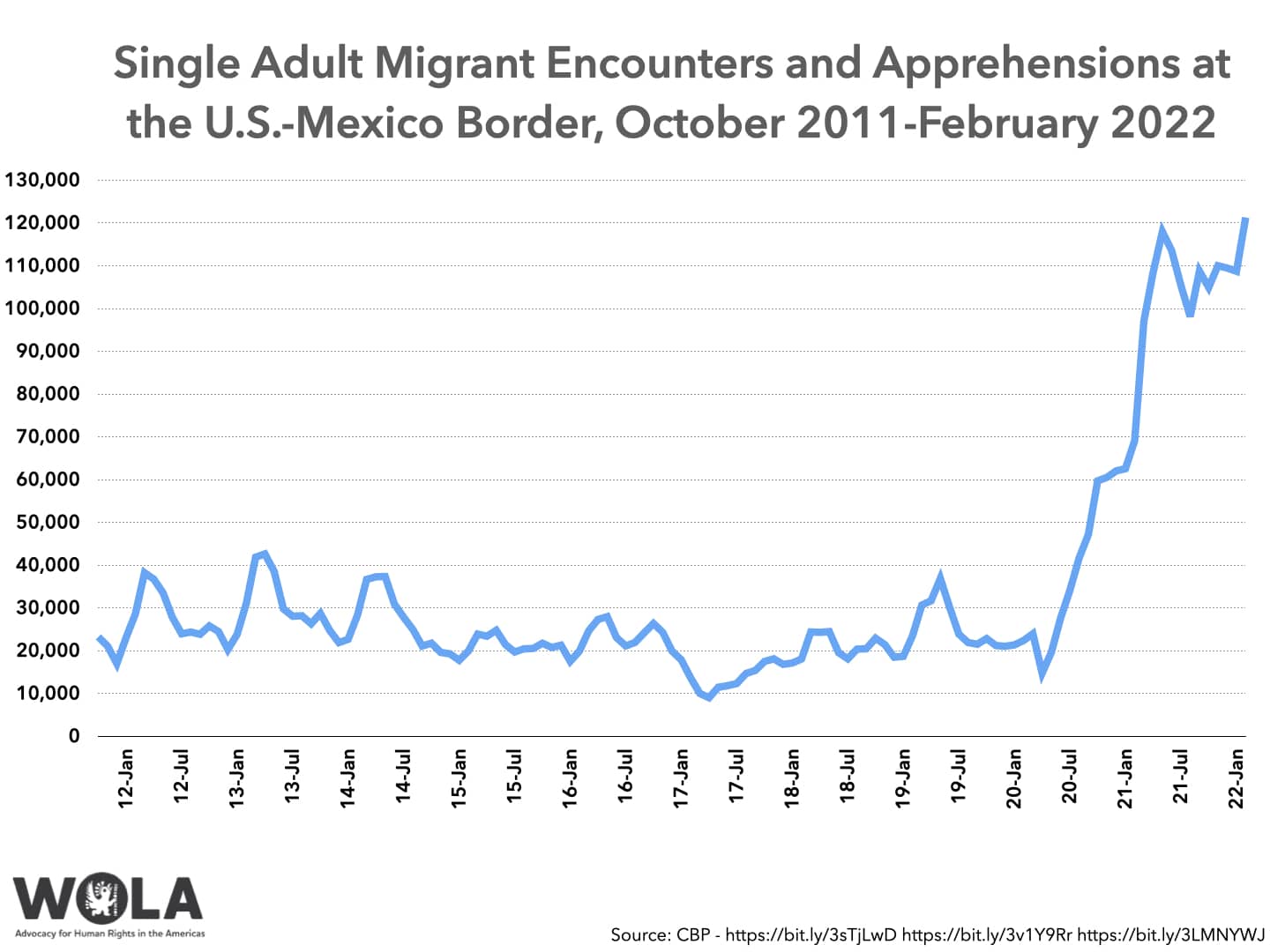
The countries that saw the most notable increases in migration in February were Colombia (up 135 percent since December), Cuba (up 107 percent), and Mexico (up 38 percent). Cuba was the number-three country of citizenship of migrants encountered at the border last month. Colombia was sixth, for the first time ever. Mexico does not require visas of arriving Colombians, so-as has happened in the past year with Brazilians, Ecuadorians, and Venezuelans-many appear to be arriving by air in Mexico and arriving at the U.S. border. Nicaragua removed visa requirements for Cubans in November, and more appear to be taking a route from Managua through Central America and Mexico.
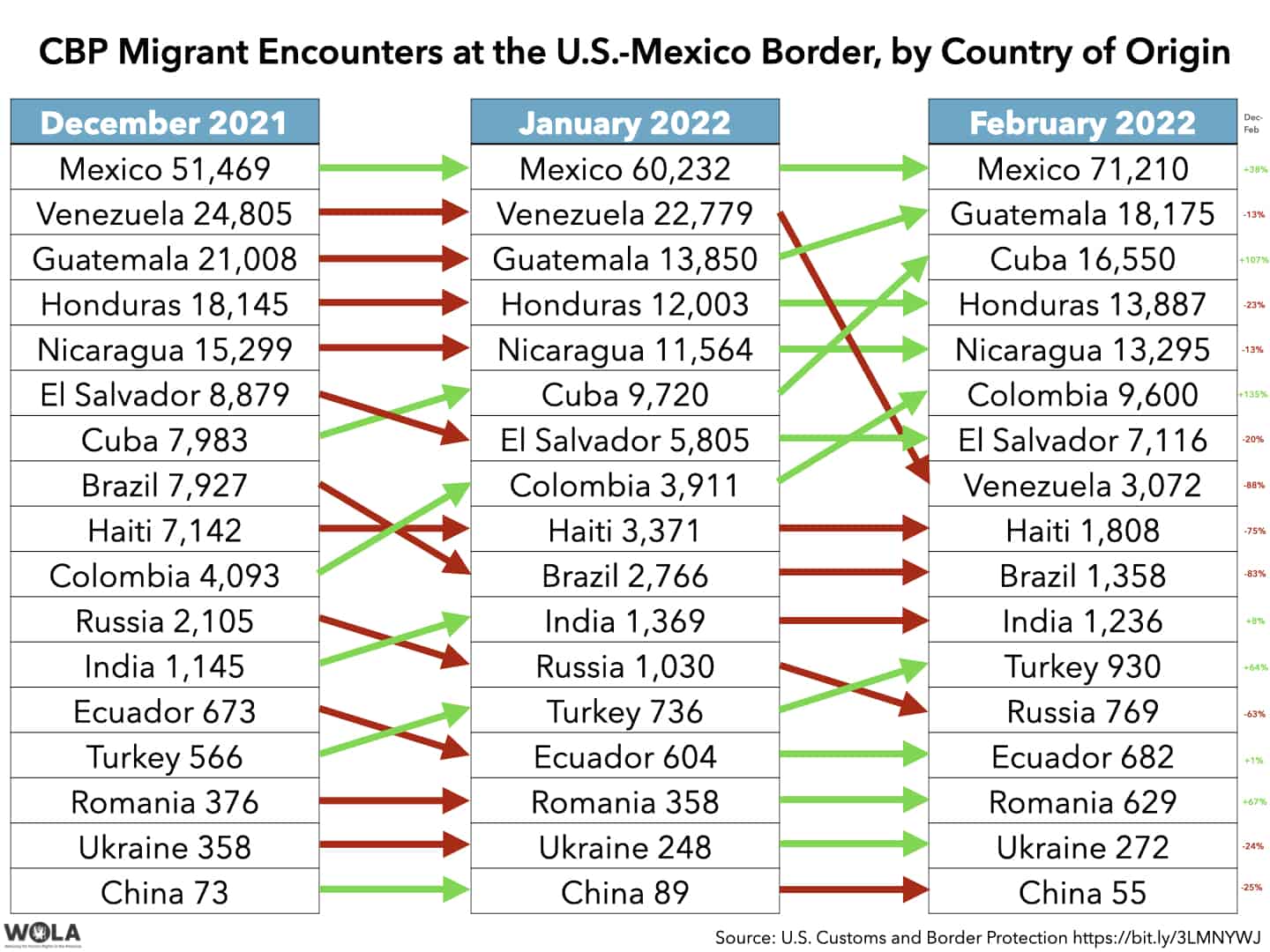
The countries that saw the most notable decreases in migration are Venezuela (down 88 percent since December), Brazil (down 83 percent), and Haiti (down 75 percent). Venezuela was the number-two country of citizenship of migrants encountered at the border in November, December, and January; on January 21, however, Mexico (at strong U.S. urging) reinstated visa requirements for Venezuelans. Encounters with Venezuelans fell from 22,779 in January to 3,072 in February.
Four countries made up 98 percent of all Title 42 expulsions in February: Mexico, Guatemala, Honduras, and El Salvador. Under an arrangement made in March 2020, Mexico accepts expulsions of all four nationalities’ citizens across its land border with the United States. Adding two more countries whose citizens get expelled by air, Haiti and Brazil, brings a total of 99.6 percent of Title 42 expulsions being applied to the citizens of six countries.
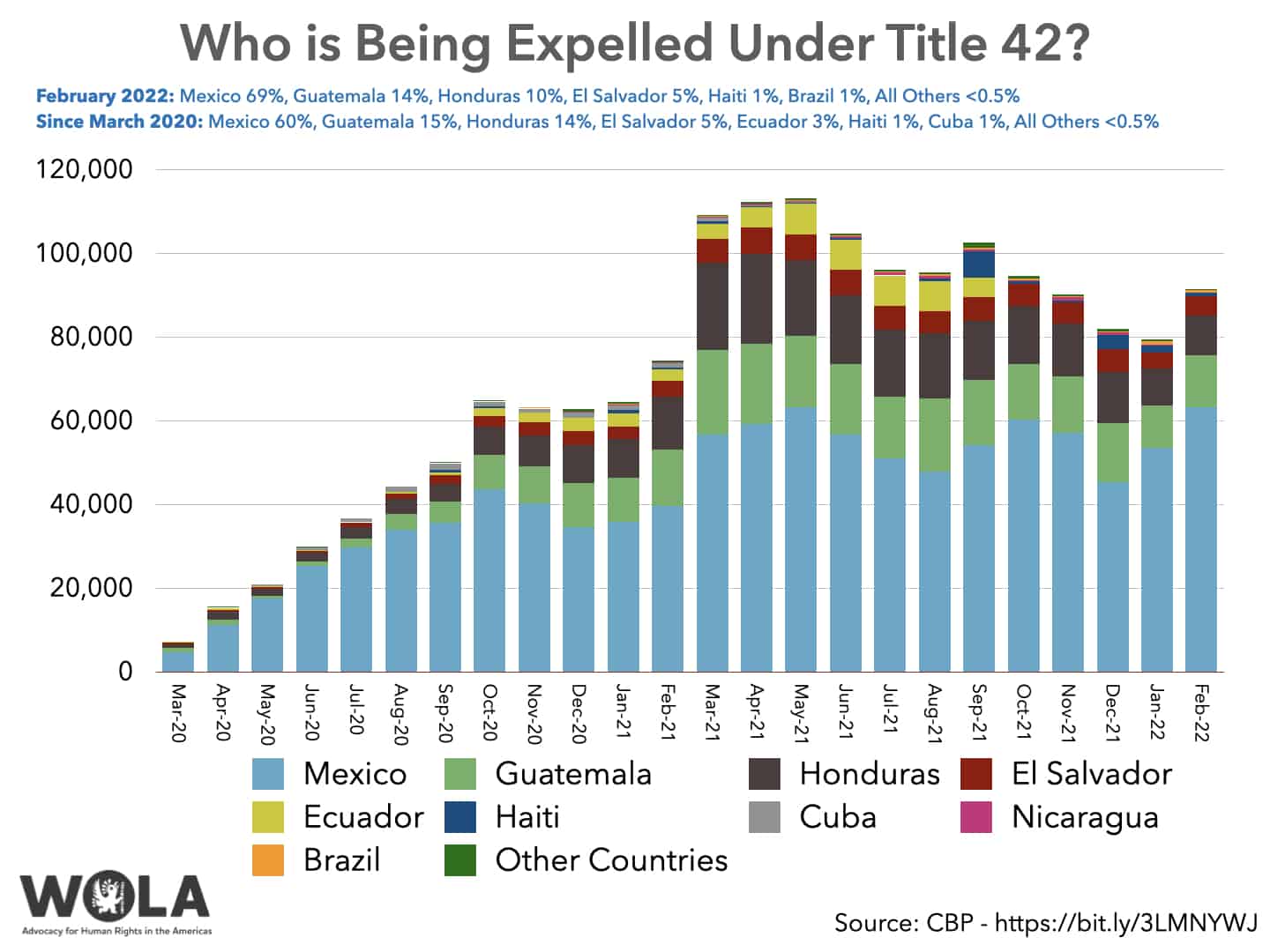
Those countries account, though, for only 69 percent of all migrants encountered in February. The remaining 31 percent comprised the other 0.4 percent of February’s Title 42 expulsions. Of those non-expelled migrants, 45 percent came from Cuba, Nicaragua, and Venezuela. Another 13 percent came from Colombia. As noted below, these are the top four countries of citizenship of migrants placed into the revived “Remain in Mexico” program.

Two until-recently quiet, remote border areas, Border Patrol’s sectors in Del Rio (Texas) and Yuma (Arizona-California), continue to see an outsized proportion of migrants from these “hard-to-expel” countries. Due to a decline in Venezuelan and Haitian arrivals, Del Rio fell out of first place among Border Patrol’s nine U.S.-Mexico border sectors-a position it occupied for the first time ever in January. Texas’s Rio Grande Valley sector, the busiest since mid-2013, regained that position.
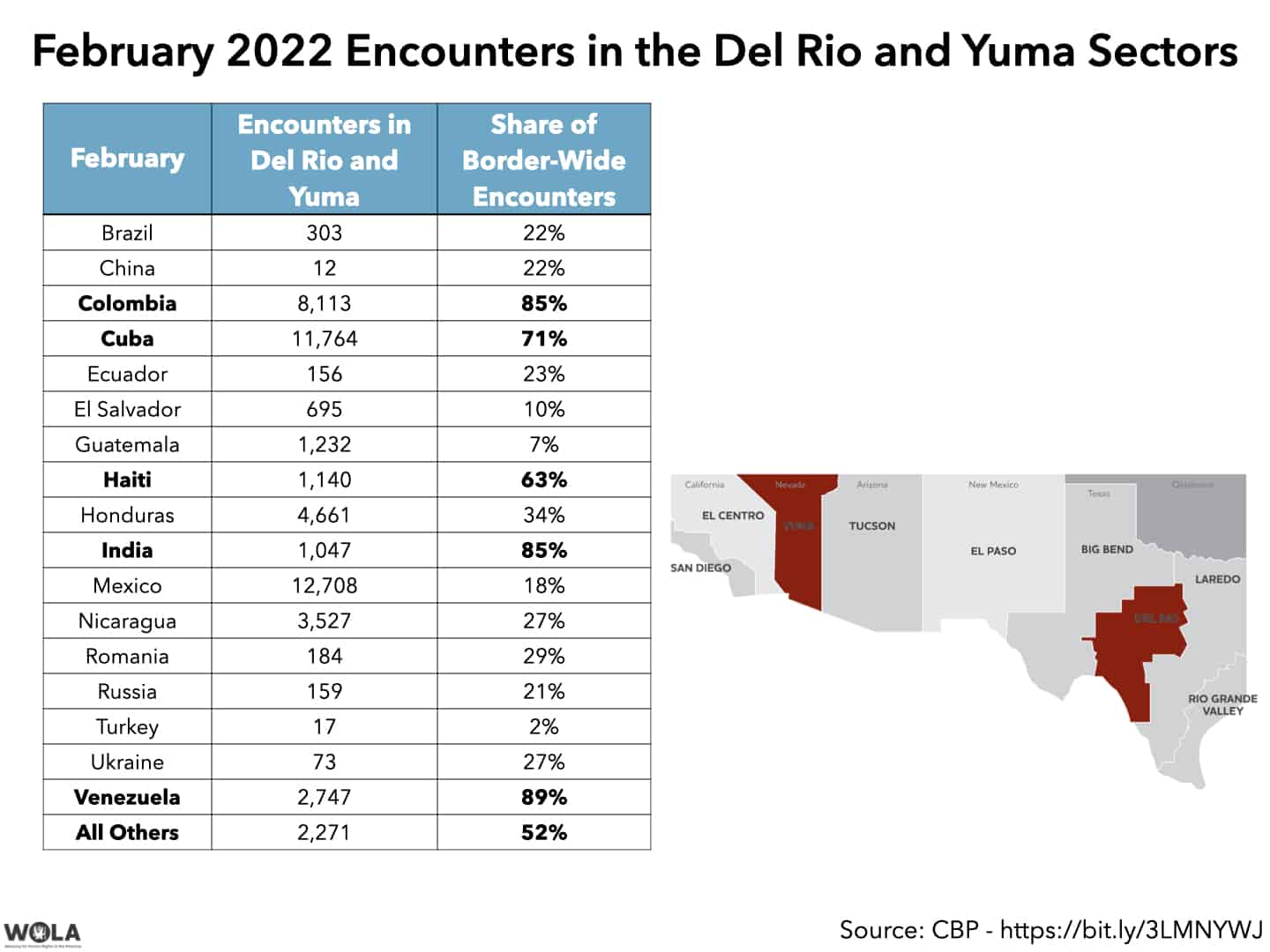
At least through February, arrivals of migrants from the Ukraine and Russia were relatively few. Most migrants from those countries, as noted above, have been arriving in the San Diego sector.
2022 budget becomes law
Five and a half months into the 2022 fiscal year, Congress has sent President Biden legislation to fund the U.S. government, which he signed on March 15. Of the budget bill’s components, one section (“Division F”) funds the Department of Homeland Security (DHS). The full bill’s text is here, and the explanatory statement for Division F is here.
The House of Representatives’ version of the DHS appropriation had reflected priorities of progressive Democrats. In the Senate, which is split 50-50 between Democrats and Republicans, a draft bill that never made it through committee hewed closer to the status quo. High-level negotiations between both houses’ leaderships resulted in Senate priorities winning out more often, as Republicans dug in on some key issues.
Most prominent of these was funding to build border wall segments. About $1.9 billion in funding appropriated in 2018 and 2019 for wall construction remained unspent. Though both houses’ draft bills sought to rescind (cancel) that wall-building money, the final budget law keeps it in place. As the law stands right now, the Biden administration is compelled to use this money to build barriers, a use of funds that DHS leadership claims to oppose. CBP has laid out plans to build about 86 miles of new border barrier and related elements in south Texas’s Starr, Hidalgo, and Cameron counties.
The bill provides $100 million “for Border Patrol hiring and contractors, retention and relocation incentives and contract support.” Rep. Henry Cuellar (D-Texas), who represents a border district and is the number-two member of the House Appropriations Subcommittee on Homeland Security, said that the money could go to hire 800 new Border Patrol personnel, bringing the agency’s workforce up to 19,555 agents. (A January DHS Inspector-General report found that Border Patrol had 19,513 agents in October, so either there has since been a lot of attrition, or Rep. Cuellar’s numbers are a bit off.)
The Washington Post reports that $21 million in funding, and perhaps a portion of a larger $276 million outlay for “border security technologies,” would expand a program of solar-powered “autonomous surveillance towers.” These mobile bundles of cameras and sensors run artificial-intelligence code produced by Anduril, a company founded by virtual-reality entrepreneur Palmer Luckey, that can apparently determine whether a moving object is an animal or a person. About 175 of these towers are currently deployed along the border, and the new appropriation could bring the total to 204. These and other gadgets are the focus of a newly founded Border Security Technology Caucus in the U.S. House of Representatives, founded by two Republican and two centrist Democratic members of Congress.
The bill also includes an additional $130.5 million, above existing appropriations, to build two new “joint processing centers” for arriving migrants at the border.
Rough week for security in Mexico border zone
On the evening of March 13 Mexico’s Army detained one of the country’s most powerful organized crime bosses, Juan Gerardo Treviño, alias “El Huevo” (“The Egg”), in the violent border city of Nuevo Laredo, Tamaulipas, across from Laredo, Texas. The city erupted in violence overnight, which persisted throughout the week, as Treviño’s men set fire to vehicles, attacked military posts, and even fired on, and threw a grenade at, the U.S. Consulate.
Treviño is the nephew of Miguel Ángel Treviño, alias “Z-40,” who led the Zetas cartel about a decade ago when it was one of Mexico’s bloodiest and most feared organizations. “Huevo’s” remnant of that group, referred to as the “Northeast Cartel,” has tightly controlled Nuevo Laredo, which bestrides the busiest land cargo border crossing in North America. On a March 9 visit to Nuevo Laredo (coincidentally five days before Treviño’s capture), WOLA’s Adam Isacson heard unanimous testimony that the Northeast Cartel not only controls the drug trade through the city, but dominates migrant smuggling and kidnapping of migrants for ransom. “Huevo’s” organization was viewed as untouchable because of its deep inroads into all local government and security institutions.
Amid the mayhem, the State Department has closed the U.S. consulate in Nuevo Laredo. “U.S. government employees have been instructed to avoid the area and shelter in place until further notice,” reads a statement from U.S. Ambassador Ken Salazar. “U.S. citizens should avoid the affected areas near the Consulate and should notify their loved ones of their well-being.” CBP briefly closed two of the border bridges’ southbound lanes between Laredo and Nuevo Laredo.
Juan Gerardo Treviño was swiftly extradited to the United States via Tijuana. He faces 11 counts related to drug trafficking and weapons possession.
Nuevo Laredo is the westernmost city in Mexico’s border state of Tamaulipas, which stretches to the Gulf of Mexico. Of Mexico’s six border states, Tamaulipas is the only one to have a level-four “Do Not Travel” warning from the U.S. State Department. Despite that, CBP has expelled 138,807 migrants into Tamaulipas from its Laredo and Rio Grande Valley sectors since October 2021, and Mexico has received another 7,411 of its deported citizens in Tamaulipas between October and January.
Further east in Tamaulipas, tense security conditions caused the exit from the U.S. consulate in Matamoros of all non-essential personnel. Matamoros is largely controlled by the Gulf Cartel, a rival of Treviño’s Northeast Cartel. Throughout the state, InsightCrime warns, a weakened Northeast Cartel could provide an entry to the hyper-violent and rapidly expanding Jalisco New Generation Cartel, which would further worsen already high violence levels.
On the other end of the border, in Tijuana, Mexico’s Army sent an additional 400 Army troops in an effort to reduce very high levels of homicides. The new personnel include “infantry, paratroopers, and special forces,” reports the Tijuana daily El Imparcial.
“Remain in Mexico” numbers
Between December 6 and March 17, 1,217 asylum seekers had been sent to Mexico under the court-ordered revival of the “Remain in Mexico” (RMX) program, CBS News’s Camilo Montoya-Galvez reported: 520 from El Paso into Ciudad Juárez; 345 from Brownsville into Matamoros and Monterrey; 296 from San Diego into Tijuana; and 57 from Laredo to Nuevo Laredo and Monterrey.
A new monthly Department of Homeland Security (DHS) “Cohort Report” table indicates that the number of asylum-seeking migrants newly enrolled into RMX more than doubled from January to February, increasing from 273 in December to 399 in January, and to 897 in February.
Many migrants initially enrolled in RMX avoid being sent back to Mexico because they demonstrated reasonable fear of harm, or due to other vulnerabilities. Those who were actually sent to Mexico and remained there, as of February 28, also more than doubled from January to February (December 209, January 253, February 551).
Nicaragua dominates among countries of citizenship of those initially enrolled into RMX.
- Nicaragua 1,111
- Venezuela 189
- Cuba 124
- Colombia 73
- Ecuador 40
- Peru 27
- Dominican Republic 3
- Costa Rica 1
- Guatemala 1
Those are initial enrollments; the DHS report does not provide the nationalities of those who remained in Mexico awaiting hearing dates.
As of February 28 all enrolled migrants had been adults, 92 percent of them male. 86 percent expressed fear of returning to Mexico. Of those who expressed fear, 18 percent received a “positive fear” determination and did not get sent back to Mexico, and another 12 percent had their cases closed.
The Biden administration continues to challenge the August order, from a Texas district court judge, requiring it to reinstate RMX, a program begun by the Trump administration. The Supreme Court will hear arguments on April 26th, and the Biden administration filed a brief this week.
Links
- The Texas Tribune found that some National Guardsmen deployed to the border by Gov. Greg Abbott (R) have been ordered to station themselves outside some of the wealthiest private ranches in south Texas. “Troops rarely saw migrants from their posts nearly 80 miles away from the border and were unable to give chase because they were not authorized to enter the private ranches.” The Texas Tribune and Army Times, which have reported extensively on this very troubled deployment of military personnel on U.S. soil, noted that-in a tacit acknowledgement that the mission has been a debacle-Abbot abruptly replaced the leader of the Texas Military Department on March 14.
- A new DHS report on domestic violent extremism within the Department’s workforce, produced at the initiative of Secretary Mayorkas, “found very few instances of the DHS workforce having been engaged in domestic violent extremism.” It warned, however, that DHS-which includes CBP, Border Patrol, and ICE-“has significant gaps that have impeded its ability to comprehensively prevent, detect, and respond to potential threats related to domestic violent extremism within DHS.”
- The director of Mexico’s migration agency, the National Migration Institute (INM), said that 1,800 of its agents have been fired during the government of President Andrés Manuel López Obrador, which began in December 2018, “for different causes, such as corruption, dishonesty or absenteeism.” In 2019 the Mexican government reported that the INM employed 4,133 agents, so 1,800 firings would represent 44 percent of the force.
- The Houston Chronicle published a lengthy and graphically vivid feature recounting Haitian migrants’ long journey from Chile to the Texas border.
- A vessel carrying 123 Haitians who had left that country five days earlier ran aground in the Florida Keys on March 14. All aboard made it to shore and are now in ICE custody.
- Border Patrol found the body of a four-year-old Nicaraguan girl whose mother lost her in the river’s current while crossing on March 4 between Ciudad Acuña, Coahuila and Del Rio, Texas.
- An annual report from Immigration and Customs Enforcement (ICE) found that the agency deported 59,011 people in fiscal 2021, “an historical low” according to CBS News. (As CBP expelled 1,071,075 people at the border under Title 42 in fiscal 2021, the overall number of people removed from the United States was historically high.)
- Hundreds of migrants unable to register themselves in Mexico’s southern border-zone city of Tapachula went to Ciudad Hidalgo, the town directly on Mexico’s border with Guatemala about 20 miles away, to try to register at INM’s facility at the port of entry. Local media said the migrants, most of them from Cuba and Venezuela, “violently broke into the customs facilities and access to the international bridge.” Personnel from Mexico’s INM and militarized National Guard then carried out a series of raids and roundups of migrants in Ciudad Hidalgo, whom the agencies placed in detention.
- “I tried twice to go to the United States, but it didn’t go well and I said: ‘If I survived in Honduras, why can’t I survive here in Tapachula? Here it’s quiet, you walk everywhere and we haven’t had any problems,'” Honduran migrant Carol Castro told the Border Hub project. Castro, who has founded a “pole dance” school in Tapachula, is among a growing number of Hondurans settling there.
- “Biden’s team is betting, it seems, that it can keep the worst of the immigration crisis confined to Mexico and that the U.S. public will continue to ignore the problem, as it long has,” reads a Foreign Affairs analysis by Ana Raquel Minian of Stanford University, who contends that this is a longstanding U.S. practice.

 Adam Isacson
Adam Isacson